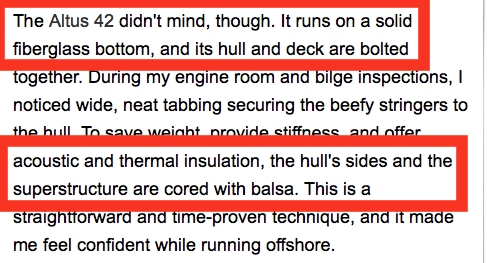Because the boat fits most of our needs(except I can`t find space for solar panels),I have persisted with it, perhaps to perseverative error, but I have my eyes open. We`ve spent 3.5 hours going all through the boat. As David says, the riser raw water injection/turbos problem may be manageable, and certainly can be dealt with at survey, by tear down if necessary, as Sunchaser wisely suggested.
The hull construction is different, it`s permanent. A simple error with a thru hull can bring on a wet rotting core. And what if it developed osmosis? Against this, there doesn`t seem to be history of Beneteau hull failures, and as the video shows they are built to a program, not cobbled together in unpredictable conditions.
I`ve raised the 2 main issues, there are others which would not deter me. We both like it as a boat,but I`m having trouble pulling the trigger. In real estate(my short post retirement fun "career") a colleague would sometimes ask "Is there a price at which you would buy it"? That`s the question,sometimes the answer is "no",I`m very close to that. I may have a chat with the broker and see if he volunteers another price. He`s entitled to the courtesy of a " thank you but no thanks".
The boat has been for sale a while, hull may be why, though trawlers don`t sell so well in Sydney. Price is not far off a Riv 40 of similar age, they`re not giving it away. I`ve a feeling they`ve lost buyers before due to the hull construction,and they may well lose another.



